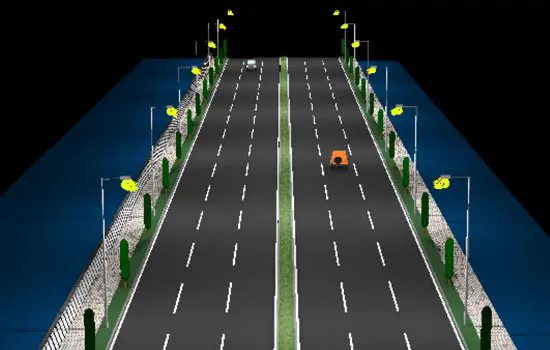| Component | Functional Requirements | Selection Parameters |
|---|---|---|
| LED Light Source | Color temperature 4000-5000K, Color rendering index ≥70 | Luminous efficacy ≥150 lm/W, IP65 protection |
| Photovoltaic Panel | Monocrystalline silicon efficiency ≥22% | Power = Daily system consumption / (Local average peak sunshine hours × 0.7) |
| Battery | Cyclic life ≥1500 times | Capacity (Ah) = Daily consumption (Wh) / (System voltage × Depth of discharge × 0.9) |
| Controller | MPPT efficiency ≥95% | Overcharge/overdischarge protection, load time-based control |

Formula:
PLED = E × A / (η × U × K)
Example: Road width 6m, distance between lights 25m, target illuminance 20 lx
→ PLED = 20 × (6 × 25) / (0.85 × 0.5 × 0.75) = 20 × 150 / 0.32 ≈ 94W
→ Choose a 100W LED module (Luminous flux 15,000 lm)
Steps:
| Road Type | Pole Height (H) | Pv Panel Angle | Installation Distance |
|---|---|---|---|
Branch Road | 4-6m | Latitude + 5° | 25-30m |
Main Road | 6-8m | Latitude + 10° | 30-35m |
Expressway | 8-12m | Adjustable bracket | 35-40m |
Wind Resistance Design: Flange size ≥ pole diameter × 1.2 (e.g.: Pole diameter 76mm → Flange 200×200×10mm)
| Time Period | Control Logic | Power Adjustment |
|---|---|---|
18:00-22:00 | Full power operation | 100% |
22:00-24:00 | Dynamic dimming (traffic detection) | 50-70% |
00:00-6:00 | Maintain minimum safety illuminance | 30% |
Backup Power: In areas with continuous rainy days ≥3days, configure a grid power complementary interface.
Component | Inspection Items | Cycle |
|---|---|---|
Pv Panel | Surface cleaning, Angle correction | Once a month |
Battery | Voltage check (≥11.5V@12V) | Once a quarter |
LED Luminaires | Lumen depreciation check (annual degradation<3%) | Once a year |
| Item | Traditional Grid Lighting | LED Solar Street Light |
|---|---|---|
Initial Investment | 8,000 Yuan | 12,000 Yuan |
Annual Electricity Cost | 600 Yuan | 0 Yuan |
Total Cost over 10 Years | 14,000 Yuan | 12,000 Yuan |
Payback Period:
Payback Period = (Price Difference / Annual Savings) = (12,000 – 8,000) / 600 ≈ 6.7 years
Project Name: New Rural Road Lighting
Through this guide, a systematic approach can be achieved from illumination requirements to economic returns, realizing a low-carbon and highly reliable road lighting solution.

Tel: +86-136 3116 6703 / +86-136 3111 8767
Email: sales@yuanfongsolar.com / victor@yuanfongsolar.com
Website: https://www.yuanfongsolar.com
Add: No.96 Xinxing Road, Jianghai District, Jiangmen City, Guangdong Province, China.
Copyright © Jiangmen Yuanfeng Lighting Appliance Co.,Ltd. All Rights Reserved. 粤ICP备2025395080号 Sitemap XML